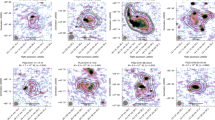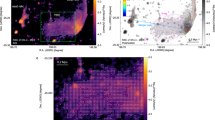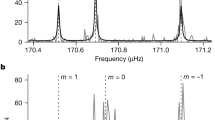Abstract
THE magnitudes of galactic magnetic fields are usually estimated from measurements of the radio synchroton emission arising from acceleration of cosmic-ray electrons in the magnetic field. To interpret the emission spectrum, it is usually assumed that the energy density in the magnetic field is equal to that in the cosmic-ray protons (which are assumed to outnumber the electrons by 100:1, as they do in our Galaxy). There is, however, no compelling justification for this assumption of energy equipartition. Here we use measurements by the Compton Gamma Ray Observatory1,2 of the γ-ray flux from the Magellanic clouds together with radio continuum data to estimate the strength of the magnetic fields in these galaxies without having to invoke energy equipartition. We find that the assumption of energy equipartition is not valid in these irregular galaxies, and that the validity cannot be restored by changing the electron/proton ratio. Supporting evidence for our conclusion comes from radio and X-ray observations (M. G. Watson, personal communication) of the starburst galaxy M82. Our results imply that these galactic fields are too large to have been generated by dynamo action alone, and we suggest that recent star formation might instead provide the generating mechanism.
This is a preview of subscription content, access via your institution
Access options
Subscribe to this journal
Receive 51 print issues and online access
$199.00 per year
only $3.90 per issue
Buy this article
- Purchase on Springer Link
- Instant access to full article PDF
Prices may be subject to local taxes which are calculated during checkout
Similar content being viewed by others
References
Sreekumar, P. et al. Astrophys. J. 400, L67–L70 (1992).
Sreekumar, P. et al. Phys. Rev. Lett. 70, 127–129 (1993).
Chi, X. & Wolfendale, A. W. J. Phys. G. (in the press).
Ginzburg, V. L. & Syrovatskii The Origin of Cosmic Rays (Pergamon, Oxford, 1964).
Haynes, R. F. et al. Astr. Astrophys. 252, 475–486 (1991).
Ye, T. & Turtle, A. J. Mon. Not. R. astr. Soc. 249, 693–697 (1991).
Westerlund, B. E. Astr. Astrophys. Rev. 2, 29–78 (1990).
Rice, W. et al. Astrophys. J. Suppl. 68, 91–128 (1988).
Heitler, W. The Quantum Theory of Radiation, 3rd edn (Clarendon, Oxford, 1954).
Klein, U., Wielebinski, R. & Morsi, H. W. Astr. Astrophys. 190, 41–46 (1988).
Parker, E. N. Astrophys. J. 163, 255–278 (1971).
Paddington, J. H., Mon. Not. R. astr. Soc. 128, 345–360 (1964).
Hoyle, F. Nature 223, 936–936 (1969).
Daly, R. A. & Loeb, A. Astrophys. J. 364, 451–455 (1990).
Rees, M. J. Q. Jl R. astr. Soc. 28, 197–206 (1987).
Lequeux, J. in Structure and Evolution of the Magellanic Clouds, IAU Symp. 108 (eds van den Bergh S. & de Boer, K. S.) 67–78 (Reidel, Dordrecht, 1984).
Chi, X. & Wolfendale, A. W. J. Phys. G16, 1409–1421 (1990).
Sukumar, S. & Allen, R. J. Nature 340, 537–539 (1989).
Author information
Authors and Affiliations
Rights and permissions
About this article
Cite this article
Chi, X., Wolfendale, A. The strength of galactic magnetic fields. Nature 362, 610–611 (1993). https://doi.org/10.1038/362610a0
Received:
Accepted:
Issue Date:
DOI: https://doi.org/10.1038/362610a0
This article is cited by
-
Magnetic fields in galaxies and beyond
Nature (1997)
-
Highlight results from the Compton gamma-ray observatory
Il Nuovo Cimento C (1996)
-
The tangled web of magnetism
Nature (1993)
Comments
By submitting a comment you agree to abide by our Terms and Community Guidelines. If you find something abusive or that does not comply with our terms or guidelines please flag it as inappropriate.



